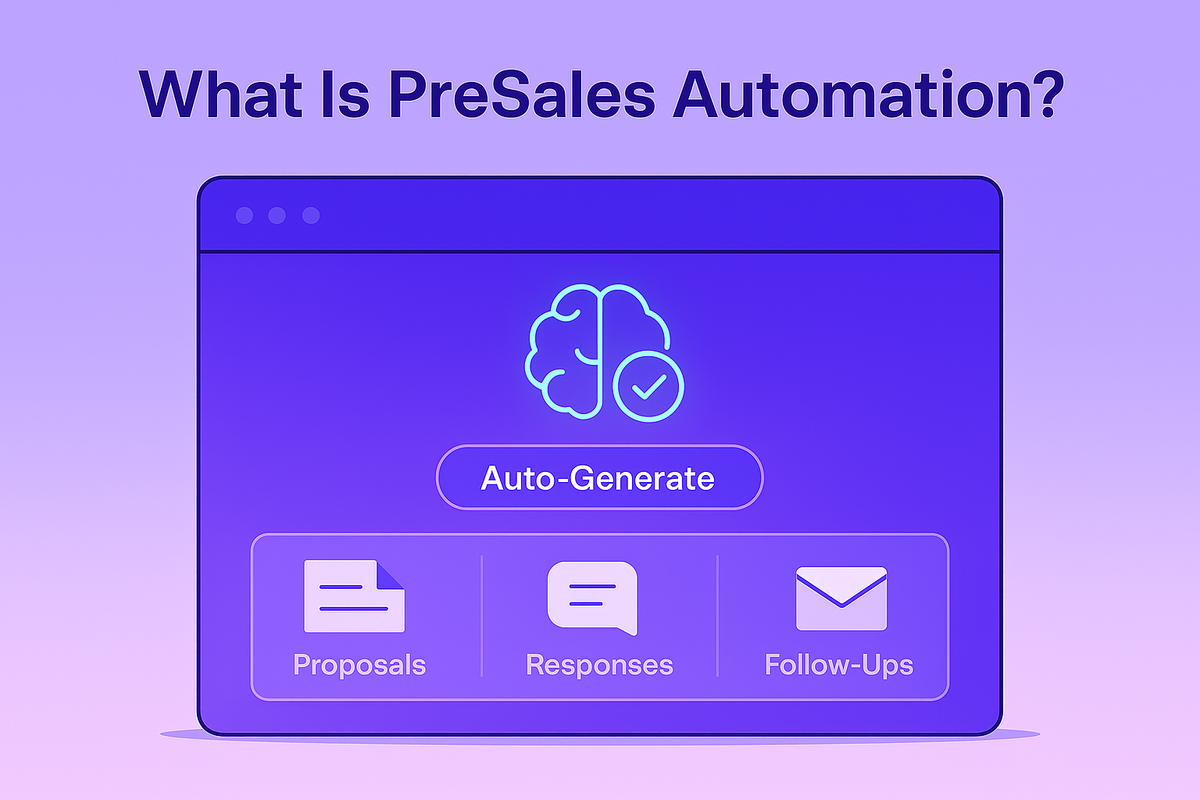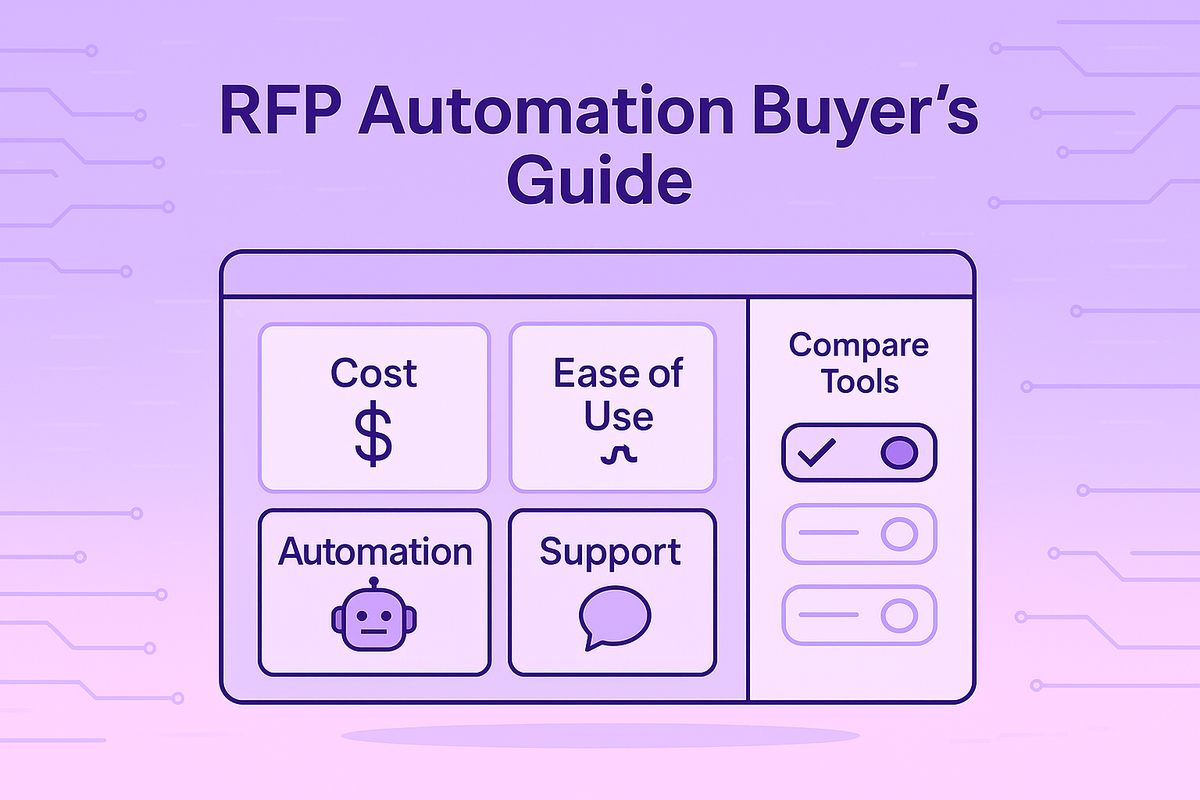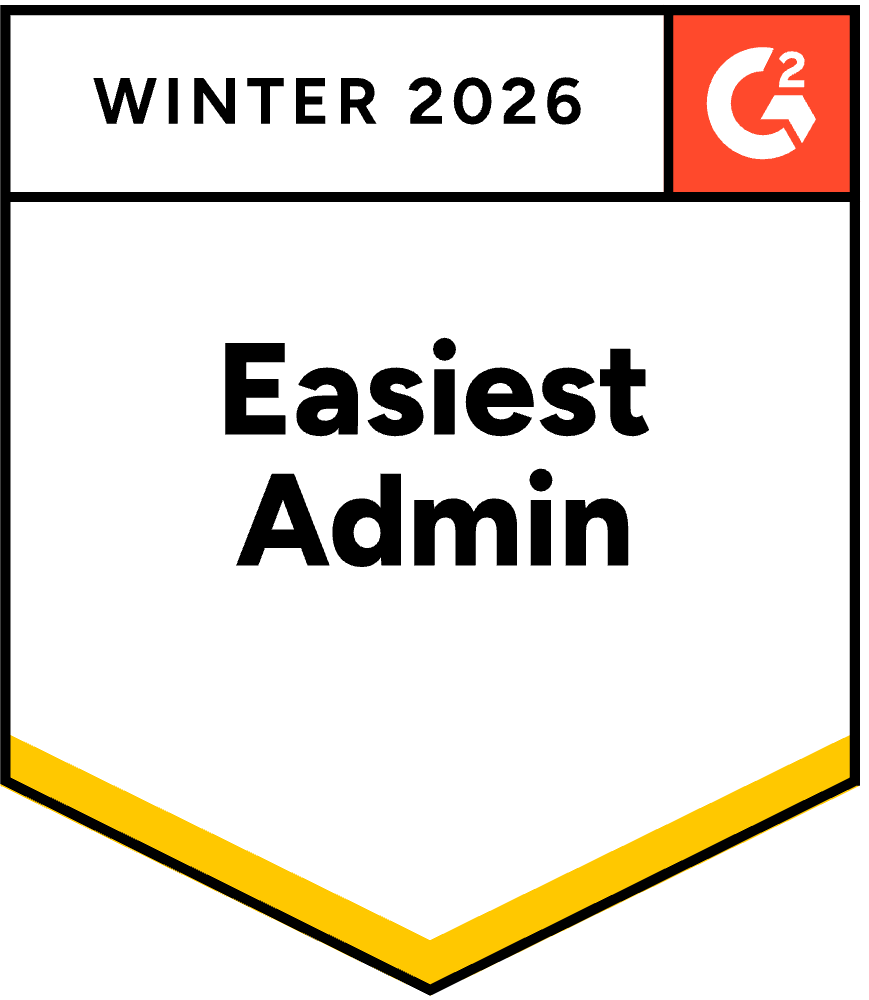How to Build an RFP Response Library (Step-by-Step)
November 7, 2025
By
Evie Secilmis

We’ve all seen the messy shared drive filled with proposal documents named "Final_v2_updated_FINAL." While it feels like you're saving past work, this digital junk drawer often creates more problems than it solves. You risk using outdated information, inconsistent messaging, and off-brand formatting, which can weaken your proposal before the client even gets to the pricing page. A true RFP answer repository is different. It’s not just storage; it’s a strategic system. It’s an intelligent, organized, and searchable library of your company’s best content. This article explains how to move beyond the chaos of shared folders and build a powerful asset that helps you win.
Key Takeaways
- Centralize Your Content to Work Smarter: An RFP repository is your team's single source of truth, not just another shared drive. It ends the frantic search for information, ensures every proposal is consistent and on-brand, and frees up your team to focus on strategic customization.
- Build a Powerful Asset with a Step-by-Step Plan: Create your repository by first gathering all your past proposal content. Next, organize everything with a logical tagging system and standardize your templates to ensure a professional, polished look for every response you send.
- Treat Your Repository as a Living Resource: A repository is only effective if it's kept current. Schedule regular content audits, train your team to contribute effectively, and use automation to help flag outdated information, ensuring your content is always accurate and trustworthy.
What Is an RFP Answer Repository?
Think of an RFP answer repository as your team's secret weapon for proposals. It’s a centralized, living library of your best, pre-approved answers to common questions found in RFPs, RFIs, and security questionnaires. Instead of starting from scratch every single time a new request comes in, your team can pull from this collection of winning content. This turns what is often a frantic scramble into a smooth, efficient process. This isn't just about storing old documents; it's about creating a dynamic knowledge base that helps you respond to opportunities faster and with much higher quality.
What It Is and Why It Matters
At its core, an RFP answer repository is a collection of your strongest, most accurate responses, organized and ready for reuse. This matters because most RFPs contain a significant number of repeated questions—often as much as 60-80% overlap. A repository allows your team to stop reinventing the wheel and instead use that valuable time to customize the proposal for the client. This means you can not only increase the volume of deals you pursue but also improve the quality of each submission. It’s a foundational tool for any sales team looking to scale its success and win more deals.
How It's Different from a Shared Drive
We’ve all experienced the pain of digging through a messy shared drive, hoping to find that one perfect answer from a proposal sent six months ago. That’s the key difference: a shared drive is just storage, while a repository is a strategic system. A true repository serves as your company's single source of truth. All content is organized, tagged, and easily searchable, which means no more accidentally using outdated product specs or inconsistent messaging. With a dedicated AI-powered platform, you can ensure every response is accurate, on-brand, and approved by the right subject matter experts, turning chaos into a streamlined workflow.
Why Your Sales Team Needs One
If your sales team is still tackling every RFP from scratch, you’re leaving time, money, and deals on the table. An RFP answer repository isn’t just a fancy folder for old proposals; it’s a strategic tool that empowers your team to work faster, smarter, and more cohesively. By centralizing your best content, you create a single source of truth that eliminates redundant work and frees up your team to focus on what really matters: crafting a winning proposal.
This shift from frantic searching to strategic selling is what separates good sales teams from great ones. Instead of reinventing the wheel for every request, your team can pull from a library of approved, high-quality answers, ensuring every response is polished, professional, and perfectly on-brand. It’s about transforming a reactive, often chaotic process into a proactive, well-oiled machine that consistently produces results.
Save Time and Work Smarter
How much time does your team spend just looking for information? Studies show that knowledge workers can spend up to 35% of their time searching for documents, and they’re only successful about half the time. When responding to RFPs, this often means digging through old emails, pinging subject matter experts for the same security questions, and rewriting answers that you know already exist somewhere.
An RFP answer repository puts an end to this cycle. It gives your team a central, searchable database where they can instantly find the information they need. This dramatically reduces the time it takes to generate a first draft, freeing up your team to focus on tailoring the proposal to the client’s specific needs. With an AI-powered deal desk, you can find accurate answers in seconds, not hours, turning a tedious task into a quick and efficient one.
Keep Your Messaging Consistent
When multiple people are contributing to a proposal, it’s easy for the final document to feel disjointed. Different team members might use slightly different product descriptions, outdated company stats, or an off-brand tone of voice. These small inconsistencies can weaken your proposal and make your company look disorganized. A well-managed repository acts as your single source of truth for all company and product information.
By creating a library of pre-written, approved answers, you ensure that every proposal that goes out the door is accurate and on-brand. This collection of vetted content guarantees that you’re always putting your best foot forward. It helps you maintain brand consistency across all your communications, building trust with potential clients and presenting a unified, professional image every single time.
Win More Deals
Ultimately, the goal of any proposal is to win the deal. An RFP answer repository directly contributes to this by improving the quality and strategic focus of your responses. When your team isn't bogged down with finding basic information, they have more time to research the client, understand their unique challenges, and customize the proposal to show you’re the perfect solution.
The most successful proposals demonstrate a deep understanding of the client's needs and industry. A repository helps you do this by providing a strong foundation of standard answers, allowing your team to spend their energy on strategic customization. By leveraging your best past responses and tailoring them to new opportunities, you can craft compelling narratives that resonate with clients. This focus on quality and personalization is what helps teams improve their win rates and drive revenue growth.
What to Include in Your RFP Answer Repository
A powerful RFP answer repository is more than just a digital filing cabinet; it’s a strategic asset. Think of it as your team’s single source of truth, a curated library of your best, most accurate, and most persuasive content. When you have the right information organized and ready to go, you can stop wasting time searching through old documents and focus on crafting winning proposals. Building a comprehensive repository means gathering a few key types of content that will form the foundation of every response you send.
Essential Templates and Frameworks
Start by creating a set of standardized templates for the common documents you produce. An effective RFP answer library is built on a foundation of pre-written answers and frameworks that help your team respond to proposals faster and with higher quality. These templates ensure every proposal that leaves your office has a consistent, professional look and feel. Include templates for your cover letter, executive summary, pricing tables, and project timelines. This "starter kit" not only saves time but also makes it easier for everyone on the team to follow best practices, ensuring no critical section is ever overlooked.
Your Best Past Responses
Don't let your hard work go to waste. Your past proposals are a goldmine of reusable content. Gather your previous RFP questions and answers—even from deals you didn’t win—and pull out the strongest material. This historical data provides incredible insight and helps you build a response database that gets smarter over time. Create a "greatest hits" collection of answers for frequently asked questions about your implementation process, customer support, and company vision. Organize them by topic so they’re easy to find, and you’ll have high-quality, proven content ready to deploy in your next proposal.
Standard Company Information
Every RFP asks for basic information about your company. Having these details pre-written, approved, and stored in your repository is a simple way to save hours of repetitive work. This section should include your official company history, mission and vision statements, executive team bios, and office locations. It’s also the perfect place to store supporting documents that add credibility to your proposals, like compelling customer case studies, testimonials, and awards. By keeping this foundational information centralized and up-to-date, your team can quickly pull the exact details they need for any proposal.
Technical and Compliance Details
This is where you store the nitty-gritty information that your subject matter experts usually handle. Documenting detailed answers on security, compliance, and technical specifications is crucial for building trust and demonstrating your expertise. Include information on your data privacy policies (like GDPR or CCPA), security certifications (such as SOC 2 or ISO), and technical architecture. Having these complex answers pre-vetted and stored in your repository ensures accuracy and consistency. It also means your team won't have to chase down engineers or legal experts for last-minute answers, streamlining the entire process with an AI-powered platform.
How to Build Your RFP Answer Repository, Step-by-Step
Building an RFP answer repository from scratch might seem like a huge project, but it’s completely manageable when you break it down into clear, actionable steps. Think of it as creating a library of your company’s greatest hits—all the information that proves why you’re the best choice for a potential client. A well-organized repository doesn’t just save time; it empowers your team to respond to opportunities with speed, accuracy, and confidence. By following this process, you can create a single source of truth that becomes one of your sales team’s most valuable assets. Let’s walk through how to get it done.
Step 1: Audit Your Current Responses
Before you can build something new, you need to take stock of what you already have. Start by gathering all your past proposal content. This includes every RFP, RFI, and security questionnaire you’ve ever answered—yes, even the ones from deals you didn’t win. Losing proposals often contain perfectly good answers that just weren't the right fit for that specific opportunity. Go through your shared drives, email archives, and local files to collect everything in one place. This initial content audit forms the foundation of your repository, giving you a rich pool of existing material to refine and organize.
Step 2: Organize and Tag Your Content
With all your content collected, it’s time to bring some order to the chaos. The goal is to make information easy to find when your team is on a tight deadline. Start by deciding on a logical categorization system. You could organize your content by product line, industry, region, or common RFP sections like "Company Overview," "Security & Compliance," or "Implementation." Then, use descriptive tags for each piece of content. A well-tagged answer can be found in seconds, saving your team from reinventing the wheel for every new proposal. This structure is what turns a simple folder of documents into a powerful, searchable database.
Step 3: Standardize Templates and Formatting
Consistency makes your brand look professional and trustworthy. A standardized RFP response template ensures that every proposal your team sends has the same polished look and feel, no matter who is working on it. Your template should include your company’s branding—logos, color schemes, and fonts—as well as pre-formatted sections for common questions. This not only saves time but also reinforces your brand identity with every document you submit. When your proposals are consistently clear, professional, and on-brand, you make a stronger impression on potential clients and stand out from the competition.
Step 4: Set Up Governance and Approvals
A repository is a living resource, which means it needs rules to stay healthy and effective. Establish a clear governance plan that outlines who is responsible for what. Decide who has the authority to add new content, who needs to review and approve answers, and how often content should be updated. Subject matter experts (SMEs) should be assigned to specific categories to ensure accuracy. Once the rules are set, train your entire team on how to use the repository correctly. Proper training ensures everyone understands the process, which helps maintain the quality and integrity of your content over time.
Step 5: Implement Search and Version Control
Your team needs to find the right answer fast and trust that it’s the most current version. This is where a simple shared drive falls short. A dedicated repository needs powerful search functionality and strict version control. You should be able to quickly locate content and see its history, including when it was last updated and by whom. This is one of the key benefits of using RFP software, which is built specifically for this purpose. These platforms replace manual searching with intelligent, AI-powered lookups, ensuring your team always pulls the most accurate, up-to-date, and approved information for every proposal.
Step 6: Integrate Your Tools
To maximize efficiency, your RFP repository shouldn’t live on an island. The final step is to integrate it with the other tools your sales team uses every day. Connecting your repository to your CRM, communication platforms like Slack or Microsoft Teams, and other sales enablement tools creates a seamless workflow. This integration allows your team to access approved proposal content without having to switch between a dozen different applications. An AI deal desk solution can serve as the central hub, pulling information from various systems and pushing updates automatically, keeping your entire sales process connected and streamlined.
Common Challenges (and How to Solve Them)
Building an RFP answer repository is a game-changer, but it’s not without its hurdles. Like any new system, it requires a bit of planning and commitment to get right. The good news is that the most common challenges are completely solvable. By anticipating them, you can create a process that sets your team up for success from day one, turning potential roadblocks into opportunities to build a stronger, more efficient sales engine. Let's walk through the four biggest challenges you might face and the practical steps you can take to solve them.
Keeping Content Up-to-Date
An answer repository is only as good as the information inside it. The single hardest part of maintaining a repository is ensuring your answers are current and accurate. If your content library is stale, even the most advanced AI tools won't be able to generate winning proposals. To solve this, schedule regular content reviews—quarterly is a great place to start. Go through your answers, remove duplicates, and update any outdated product specs or company information. An AI-powered platform can proactively flag outdated content across your systems, making this process much easier to manage.
Encouraging Team Adoption
You can build the most beautiful repository in the world, but it won’t help you win deals if your team doesn’t use it. Getting everyone on board is essential. The key is to make it a collaborative effort. Host a training session to show everyone how to search for answers, add new content, and follow your established guidelines. When your team understands how the repository saves them time and helps them perform better, they’ll be more likely to contribute. Sharing success stories from other teams can also show them what’s possible and get them excited to participate.
Balancing Quality and Speed
Sales teams are always under pressure to move fast, but speed should never come at the expense of quality. The whole point of a repository is to improve both. When your team has to hunt through old documents and shared drives for answers, they lose valuable time that could be spent personalizing the proposal. A well-organized library prevents this by putting approved, high-quality answers at their fingertips. This frees them up to focus on strategic customization rather than tedious information gathering, helping you produce better proposals in less time.
Integrating with Your Sales Process
For your repository to be truly effective, it needs to feel like a seamless part of your team’s workflow, not just another tool they have to log into. Since most RFPs have a significant overlap in questions, reusing answers is a huge time-saver. The right software can integrate directly with your CRM and other sales tools, making it easy to pull approved content into new proposals. This creates a smooth, efficient process that helps your team manage a higher volume of RFPs without getting bogged down, ultimately improving your capacity and win rates.
Maintaining Your Repository for Long-Term Success
Building your RFP answer repository is a huge first step, but the real magic happens when you treat it as a living, breathing resource. An unmaintained repository can quickly become a digital graveyard of outdated stats and irrelevant answers. To make sure your hard work continues to pay off, you need a solid plan for keeping it fresh, accurate, and useful for your entire team. Think of it less like a project you finish and more like a garden you tend to. A little consistent effort ensures you’ll always have the best content ready to go, helping you respond faster and win more deals.
Schedule Regular Content Audits
Your company is always evolving—products get updated, messaging gets refined, and new case studies become available. Your repository needs to reflect these changes. Scheduling regular content audits is the best way to keep everything current. Set aside time every quarter or twice a year to go through your answers. During this review, your goal is to find and fix any information that’s become stale. Look for outdated product features, old company statistics, or messaging that no longer aligns with your brand. This is also a great time to remove duplicate entries and choose the single best version of an answer. By making this a recurring process, you ensure your team can always trust the content they find, which is crucial for building high-quality, accurate proposals.
Train Your Team for Success
A powerful repository is only effective if your team knows how to use it. Proper training is key to getting everyone on board and making the most of this resource. Start with a kickoff session to walk everyone through the platform, showing them how to search for content, add new answers, and flag information that needs an update. Getting your team involved from the start helps build a sense of shared ownership. But training shouldn't be a one-time event. As new team members join, make repository training a standard part of their onboarding. You can also hold brief refresher sessions to share new best practices. The goal is to make using the repository a natural part of everyone's workflow, as shown in customer success stories.
Track Your Performance
How do you know if your repository is actually making a difference? By tracking its performance. Keeping an eye on a few key metrics will not only prove the repository's value but also help you identify areas for improvement. Start by measuring the time it takes your team to complete an RFP before and after implementing the repository. You should see a significant drop as people spend less time hunting for information. You can also track the number of proposals your team can handle and, most importantly, your win rate. An increase in these numbers is a clear sign that your repository is helping you produce better proposals more efficiently. Sharing these wins with your team can also encourage continued adoption and contribution, helping you achieve your sales goals.
Use Automation to Stay Current
Manually auditing and updating hundreds or thousands of answers can feel like a monumental task. This is where automation can be a game-changer. Modern RFP software uses AI to make repository management much easier and more effective. Instead of relying solely on manual checks, these tools can proactively identify content that might be outdated. For example, an AI-powered platform can flag answers containing old dates or statistics and suggest updates, ensuring your information stays fresh. Automation helps you manage a large volume of content without overwhelming your team. It streamlines the review process, reduces the risk of human error, and frees up your subject matter experts to focus on crafting strategic, winning responses rather than doing administrative cleanup.
Related Articles
- RFP Guide: How to Write, Respond, & Win
- Turning RFPs into a Competitive Edge
- Best RFP Software for Small Businesses (2025 Guide)
- 5 Best RFP Automation Platforms for Small Businesses
Frequently Asked Questions
How is an RFP repository really different from the shared drive we already use? Think of a shared drive as a digital storage unit—you can put things in it, but finding what you need is often a chaotic mess of outdated files and confusing folder structures. An RFP repository, especially one powered by dedicated software, is more like a smart library. It’s an active system designed to give you the right answer, right now. It has powerful search, version control to ensure you’re using the most current information, and a clear process for keeping content accurate and approved.
This sounds like a lot of work upfront. How long does it really take to build? It’s true that the initial setup requires a focused effort, but it’s an investment that pays for itself very quickly. The heaviest lift is the initial content audit where you gather and organize your past responses. Depending on how much content you have, this can take anywhere from a few days to a couple of weeks. Once that foundation is in place, maintaining it becomes a much smaller, ongoing task. The time you save on your very next proposal will make the initial work feel completely worth it.
Is a repository worth the effort if I’m on a small sales team? Absolutely. In fact, it can be even more valuable for a small team. When you have fewer people, every minute counts. A repository allows a small team to operate with the efficiency and consistency of a much larger one. It ensures that even without a dedicated proposal manager, every response that goes out is polished, professional, and on-brand. It’s a tool that helps you scale your efforts and compete for bigger deals without needing to add more people.
How do I get my team to stop saving answers on their desktops and actually use the repository? The best way to encourage adoption is to make the repository the easiest and most reliable way to get work done. If your repository is faster and more trustworthy than digging through old emails or a messy drive, your team will naturally start using it. This means ensuring the search function is excellent and the content is always up-to-date. It also helps to lead by example and celebrate the wins—like a quickly turned-around proposal—that were made possible by using the repository.
With AI getting so good, why do I need a repository? Can’t AI just generate new answers? That’s a great question. While generative AI is incredibly powerful, it works best when it has high-quality, accurate source material to pull from. Your repository serves as that perfect source material—your company’s single source of truth. An AI platform can then use your curated, pre-approved answers to generate first drafts that are not only fast but also perfectly aligned with your brand voice and technical specs. It’s about combining the speed of AI with the proven quality of your best content.
Share this post
Link copied!




















